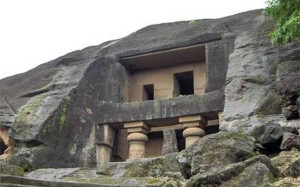A team of experts discovered ancient Buddhist caves at Mumbai National Park in India. They found a total of seven caves that they assume to be at least 2,000-years old. The caves are possibly dated between the 1st century B.C. and 5t to 6th century A.D. These caves are believed to be Buddhist viharas or monk residences, that were used by the monks as a shelter during the monsoons. The report says that even though the site still awaits a formal approval from the Archaeological Survey of India (ASI) for more detailed exploration and documentation with regards to these new caves, they are believed to have been constructed way before the nearby Kanheri Caves, between 1st century BC and 5th-6th century AD.
Although all the caves indicate strong evidences of being viharas, one of them has shown the remains of harmika, which refers to the top railing of a stupa. The discovery was made in February last year, and is said to be the result of a systematic survey of the area, which included a detailed study of the area’s topography and water sources, followed by extensive field work
Mugdha Karnik, head of Mumbai University’s Centre for Extra-Mural Studies said that many people do not know the history and culture of the country. He believes that such discoveries will help people learn about their heritage and in turn, protect these structures from destruction posed by industrialization and construction of new buildings.
Learn Inclusively – Improve Your Vocabulary
- Residence means a person’s home
- Topography means the arrangement of the natural and artificial physical features of an area.
- Heritage means a special or individual possession.







